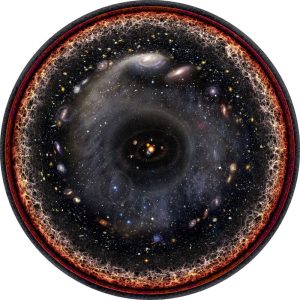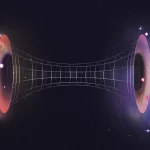Key Takeaways:
- Witness the beauty of the observable Universe through a stunning logarithmic scale image, placing the Solar System at its epicenter.
- Created by musician and artist Pablo Carlos Budassi, this masterpiece combines Princeton University’s logarithmic maps and NASA’s telescope observations.
- Logarithmic maps, crafted by astronomers J Richard Gott and Mario Juric at Princeton, provide a unique perspective on the vastness of the Universe, published in the Astrophysical Journal in 2005.
- Pablo Carlos Budassi’s creative vision turned these logarithmic maps into a mesmerizing, giant circle, offering a more accessible and visually appealing representation.
- Explore the intricacies of the Universe, from the inner planets to the cosmic web, and marvel at this cosmic artwork that originated from hexaflexagon drawings for a birthday celebration.
The observable Universe, a majestic expanse of cosmic wonders, is unveiled in all its splendor through an awe-inspiring logarithmic scale image.
 This visual masterpiece, with the Solar System proudly at its core, is the brainchild of musician and artist Pablo Carlos Budassi. Drawing inspiration from logarithmic maps crafted by Princeton University researchers and images provided by NASA’s telescopes, Budassi has transformed complex data into a captivating artistic representation.
This visual masterpiece, with the Solar System proudly at its core, is the brainchild of musician and artist Pablo Carlos Budassi. Drawing inspiration from logarithmic maps crafted by Princeton University researchers and images provided by NASA’s telescopes, Budassi has transformed complex data into a captivating artistic representation.
In this logarithmic odyssey, the Solar System takes center stage, encircled by the inner and outer planets, the Kuiper belt, the Oort cloud, the Alpha Centauri star, the Perseus Arm, the Milky Way galaxy, the Andromeda galaxy, nearby galaxies, the cosmic web, cosmic microwave radiation, and the invisible plasma remnants of the Big Bang at the Universe’s very edges. The sheer scale of this illustration is mind-boggling, inviting viewers to delve into its details.
The groundwork for this cosmic tapestry was laid by astronomers J Richard Gott and Mario Juric from Princeton University, who based their logarithmic map on data from the Sloan Digital Sky Survey. Over the past 15 years, this survey utilized a 2.5-meter wide-angle optical telescope at the Apache Point Observatory in New Mexico to create detailed three-dimensional maps of the Universe, including spectra for over 3 million astronomical objects.
Logarithmic maps serve as a vital tool for comprehending the unimaginable vastness of the observable Universe. By incrementing each axis by a factor of 10, these maps provide a more manageable visualization. Although these maps are scientifically crucial, they lack aesthetic appeal. It was here that Pablo Carlos Budassi stepped in, infusing artistry into the scientific realm.
Budassi’s creative journey began while crafting hexaflexagons for his son’s birthday. Hexaflexagons, those deceptively intricate paper polygons, sparked the idea of a logarithmic view of the cosmos and the Solar System. Armed with images from NASA and his own textures, Budassi meticulously assembled this grand logarithmic circle using Photoshop, bringing to life a visually striking representation of our cosmic surroundings.
As you explore the uncropped and zoomable versions of this logarithmic masterpiece, consider the intricate details meticulously pieced together by Budassi. In this visual journey, each element tells a story, from the intricacies of the inner planets to the vastness of the cosmic web, offering a unique perspective on the observable Universe.
In conclusion, Pablo Carlos Budassi’s artistic interpretation, fueled by scientific data and creativity, invites us to marvel at the majesty of the Universe. This logarithmic journey, born from hexaflexagons and logarithmic maps, seamlessly merges science and art, providing a gateway to comprehend the boundless wonders that surround us in the cosmos.


